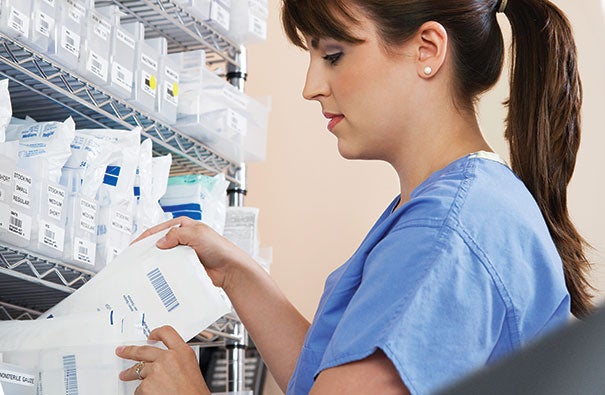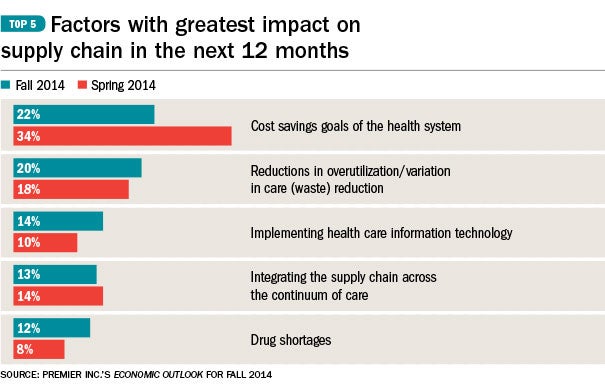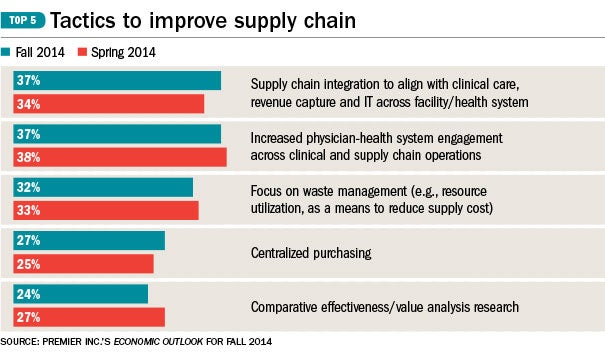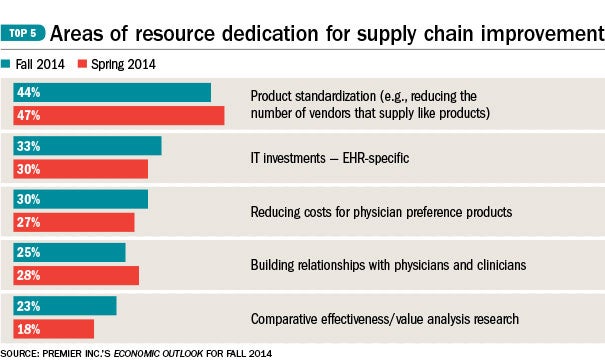High-tech supply chain software pays off
 |
| PHOTO BY MOODBOARD/THINKSTOCK Hospitals are using technology to get a better sense of which products are on their shelves at what times, their true costs and whether they work as intended for patients. |
In February, Franciscan Missionaries of Our Lady Health System (FMOLHS) in Baton Rouge, La., embarked on an ambitious project to build a more efficient supply chain management process.
The five-hospital system enlisted its seven largest contracting manufacturers to participate in the pilot. The process included mapping every step that an individual item takes through the supply chain — from ordering to the loading dock to inventory to the clinician to the patient — and then automating it into one central computer system.
As of November, all seven manufacturers are integrated with the new system, designed in-house. FMOLHS requires these manufacturers to provide a location identification using a Global Location Number and a Global Trade Item Number (GTIN), that can track products end-to-end.
“It is one unique and constant number,” explains Sandi Michel, director of supply chain systems and quality at FMOLHS, who conceived and executed the new system. “We are recognizing this one consistent number and it reduces the opportunity for errors,” Michel says. “It is about the right product, the right contract, the right price, the right patient, the right time and the right physician.”
The GTIN allows manufacturers and the health system to be on the same page in terms of all aspects of supply management, Michel says. All steps — from the purchase order, packing slips, reconciliation between orders and receivables, invoices and accounts paid — are automated. “It’s completely touchless,” Michel says.
As a result of this change, supply buyers at FMOLHS are saving about two hours per day that they previously needed to review purchase orders and manually release them to manufacturers. These hours alone save the system an estimated $56,000 annually, Michel says.
Supply chain tools
FMOLHS is just one example of hospitals and health systems that are incorporating new technologies to better manage the supply chain. As a result, hospitals like FMOLHS are beginning to get a better sense of which products are on their shelves at what times, their true costs and whether they work as intended for patients.
New regulations by the Food and Drug Administration (FDA) on tracking implantable medical devices — and expected further rules on hospitals’ role in this tracking next year — are, in part, driving the trend. Another driver is health care reform, as hospitals seek new ways to become even more efficient and responsible for the overall health of their patients.
“It’s not just the price you pay for a product, but does this product reduce infection, lower readmissions, lower lengths of stay?” asks Karen Conway, executive director of industry relations at GHX in Colorado Springs, Colo. “Hospitals and health care systems are recognizing that they need that level of data to survive health care reform and improve and do better.”
With technology to enhance supply chain efficiencies comes a bevy of new acronyms. Real-time location systems (RTLS) manage and track assets such as medical equipment and enterprise resource planning (ERP) systems provide a comprehensive application that melds materials management, accounts payable, financials, human resources and other systems into one linked system. Radio-frequency identification (RFID) tags are used to track and monitor products throughout a hospital or system, and electronic data interchange (EDI), transmits orders directly to a distributor, moving away from a phone-based purchase ordering system.
Essentially, all these tools can work together to help supply chain professionals and hospital administrators capture a more complete picture of their inventory than ever before, says Mike Schiller, CMRP, director of supply chain at the Association for Healthcare Resource & Materials Management.
An ERP system, for instance, that brings together disparate financial, inventory management and other systems into a singular database, is a mainstay in the hospital field, he says.
Handheld scanners and bar codes also are becoming the norm in hospitals and clinics for inventory management, Schiller adds. Scan an item location and the system will automatically calculate the reorder amount based upon the difference between the current on-hand inventory balance for that item, and the par level.
Similarly, closed point-of-use cabinetry, which requires personnel to log in before taking an item from a locked shelf, allows hospitals to know who is using which items and when they need to be replenished. Open point-of-use systems track inventory leaving the shelves, but doesn’t require a personal login.
“These point-of-use tools offer tremendous replenishment automation opportunities as well as comprehensive usage information for improved inventory management, including increased charge capture and inventory utilization,” Schiller says. “A downside is the potential costs and space requirements associated with these systems.”
One low-tech and low-cost solution for inventory management emerging at hospitals is called “kanban,” which originated in the auto industry. The way it works is that frequently used items like syringes are stored in a long bin on a wire shelf. Nursing staff pull syringes as needed from the bin. Halfway into the bin is a red card indicating that supply is low. When a nurse reaches the red card, he or she will take the card out and put it in a designated place near the bin to show material managers that the syringe bin needs replenishing.
“Compliance for kanban is typically found to be higher than the closed cabinet point-of-use systems which require a login process. With the kanban system, the supplies are openly available to the nurse and it’s not a workflow disruption to pull the card out,” Schiller says. “And they offer an alternative to the closed cabinetry systems.”
Sophisticated tracking
However, not everything is as simple as kanban, and hospitals are gearing up to meet possible requirements that could call for much more sophisticated tracking of certain medical devices.
On Sept. 24, the FDA went live with a rule requiring manufacturers of Class III medical devices — such as stents and other high-risk implantable devices — to place a unique device identifier (UDI) on each device. The FDA maintains a global UDI database that allows it to conduct post-market surveillance on the devices.
Today, hospitals aren’t required to use the UDI except to report that number to the FDA in case of serious patient injury or death. However, the Office of the National Coordinator for Health Information Technology is mulling requiring hospitals to include UDIs in patient electronic health records (EHRs) as part of certification of meaningful use Stage 3.
Lower-risk medical devices must carry UDIs as part of FDA rules over the next few years, and within two years, about half of products used in health care will have a UDI, says Conway of GHX.
Hospitals should view the UDI rules as an opportunity, says Conway. “You start to know what attributes of the product work on what patients,” she says. “It starts helping us with individual care and good population data.”
Mercy, the fifth largest Catholic health system in the United States with corporate offices in St. Louis, worked with the FDA on an 18-month UDI demonstration project to test feasibility of implementing UDI information into an EHR and to see whether that data could help with patient care and outcomes. Mercy and the FDA implemented a coronary artery stent UDI-based surveillance system in the EHR at all Mercy locations, which includes a database that can be queried for outcomes such as stent safety, reliability of different devices and short- and long-term clinical outcomes. Mercy is finding that implementing UDI data into the EHR is producing meaningful data on products and patients. For instance, the FDA pilot revealed that one vendor lost $300,000 of expired product over a six-month period. It also has improved charge accuracy and reconciliation.
“We are expecting that, at some point, hospitals will be required to track UDI use and outcomes,” says Curtis Dudley, vice president of integrated performance solutions for Mercy. “These are just the right things to do from a patient safety perspective.”
Franciscan Missionaries of Our Lady Health System is expecting the same. It is kicking off Phase 2 of its supply chain management redesign by integrating product information into its EHR, including UDIs. The supply chain system also will be integrated into the hospital system’s financial structures and for mandated reporting to cardiology boards and federal regulatory agencies, Michel says.
Improving efficiency
“It’s about improving patient safety and ensuring that we are not receiving or using counterfeit products, and that we have taken out all of the wasted steps,” Michel says. “We are giving back time to our clinicians to spend with patients rather than on administrative duties.”
is a freelance writer based in San Francisco who specializes in health care topics.







